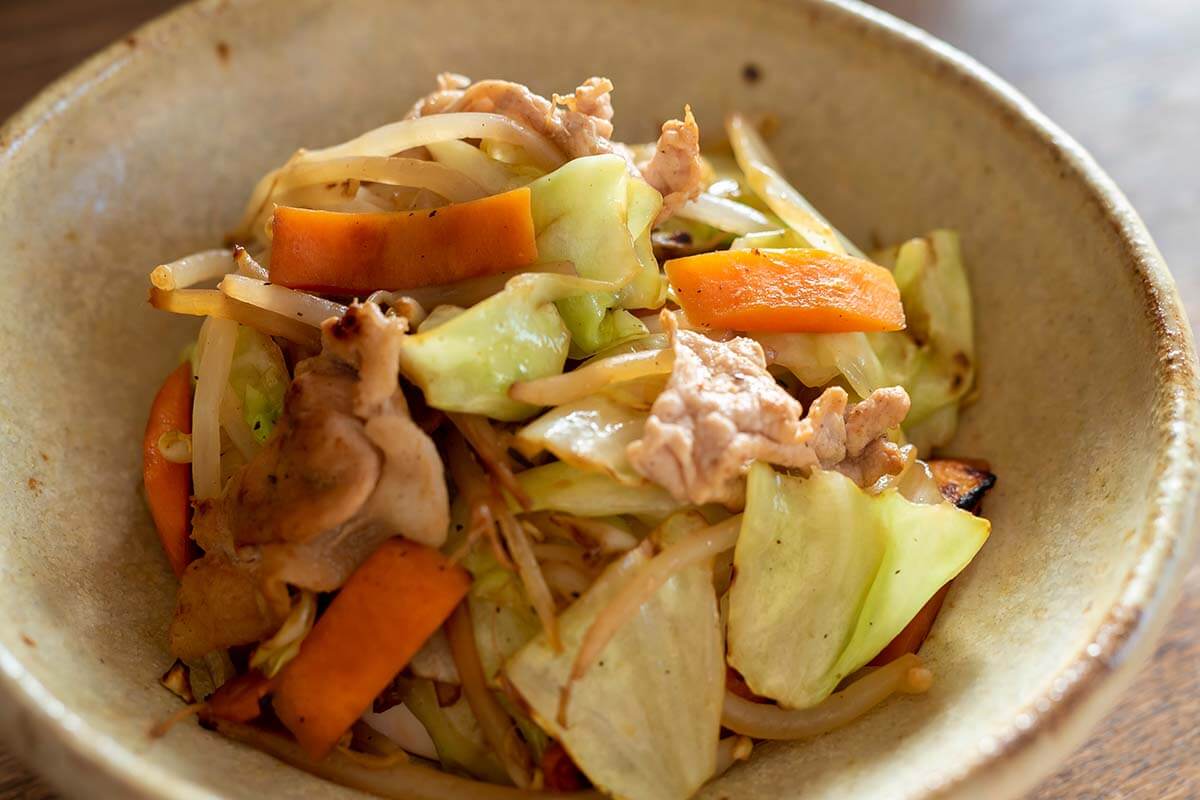Stir-Fried Vegetables
Last October, American food professionals visited fermented food producers to deepen their knowledge of Japanese fermentation culture during the “Hakko Tourism in Japan” tour campaign. As part of the tour, organizers held a tasting session where guests gave candid advice from the perspective of the American market to food product manufacturers looking to enter the United States market.
When asked, “Do you cook?”, a common answer from people who don’t like to cook is “I can cook stir-fried vegetables.”
Take the vegetables you have at home, cut them into chunks, fry them quickly, pour soy sauce over them, turn off the heat, and stir-fried vegetables are ready to eat. If you are really into cooking, you can go deep, but remember that the appeal of stir-fried vegetables is that they are easy for anyone to make with just a few ingredients.
It is also a flexible dish which allows you to combine ingredients that you have at home, such as mushrooms, meat or seafood, as well as add your favorite seasonings such as black pepper, sake or vinegar.
And because it’s a simple dish, you can change the taste in a myriad of ways by changing the type of soy sauce you use.
I chose soy sauces with the most typical and popular flavor to make this as helpful as possible. The usu-kuchi and koi-kuchi types were from major brands. The shiro, sai-shikomi, and tamari types were the ones with the fewest peculiarities. Overall, I compared the flavors using soy sauces that had clean and elegant tastes.

Ingredients (Practically anything)
- Vegetables of your choice (cabbage, carrots, bean sprouts, onions, bell peppers, etc. are typical ingredients in Japan)
- Oil
- Soy sauce
You can also add more of your favorite ingredients such as mushrooms, meat, seafood, garlic, etc. and seasonings such as black pepper, sake, vinegar, etc.
Directions
- Cut the ingredients into thin, bite-sized pieces.
- Add oil to a frying pan, and first add and fry the ingredients that take longer to cook such as carrots and onions over medium heat.
- When the ingredients are cooked, turn heat to medium-to-high and add cabbage, bean sprouts, green pepper, and other ingredients that are easily cooked, immediately pour soy sauce over them, and then turn off the heat.
* If you are adding garlic, meat or seafood, cook them before the vegetables.
Taste Test
Shiro Soy Sauce (Lightest in Color and Sweetest in Flavor)
Shiro soy sauce does not add color to vegetables, so vegetables are brightly colored. The soft sweet aroma and taste of koji spread softly in your mouth, and as you chew, the sweetness of the vegetables and soy sauce delicately overlap each other, tickling your heart.
Usu-kuchi Soy Sauce (Moderate in Color and Aroma; Salty)
The harmony of the elegant aroma of usu-kuchi soy sauce and the green aroma of vegetables is exquisite. The flavor of each vegetable is enhanced, and as you chew, the sweet and savory flavors of the vegetables combine to create a rich flavor. The taste of the vegetables is admirable.
Koi-kuchi Soy Sauce (the Standard of Soy Sauce; An Excellent Balance of Five Flavors)
The real taste of soy sauce, its fragrant aroma, fills the air, tempting you to dig in. From the moment you put it in your mouth, the flavors of both soy sauce and vegetables, as well as the freshness of the vegetables, coexist in a harmony without blending into one another.
Sai-shikomi Soy Sauce (Double Brewed: Both Brewing Time and Quantity of Ingredients are Double Those of Koi-kuchi Soy Sauce)
The savory and deep aroma will increase your appetite and reach for more. At first, the taste of the soy sauce and the freshness of the vegetables remain without blending in. Then, as you continue to chew, it blends in to create an exquisite harmony. This change in flavor makes the dish so enjoyable and irresistible.
Tamari Soy Sauce (Soybeans are the Main Ingredient; You Can Enjoy its Deep Flavor)
The deep, soothing aroma gives the dish an air of luxury that you would not expect from an impromptu meal. The flavorful soy sauce spreads in your mouth and as you continue to bite, the delicate taste of the vegetables softly emerges.
In conclusion, you can enjoy the sweetness of white soy sauce, the natural flavor of vegetables in usu-kuchi soy sauce, the taste of both soy sauce and vegetables in koi-kuchi soy sauce, and the deep flavor of sai-shikomi soy sauce and tamari soy sauce. There is no single correct way to make stir-fried vegetables. Feel free to enjoy by changing the type of soy sauce and adding other ingredients and seasonings.
Keiko Kuroshima, the world's first soy sauce sommelier and certified sensory inspector, hails from Japan's soy sauce production hub in Shodoshima. She co-authored a book on the island's breweries and is the only female among the three soy sauce sommeliers worldwide. Her expertise and passion elevate soy sauce appreciation globally.

